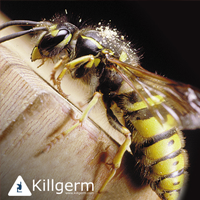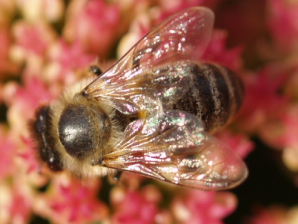Book a pest control treatment for wasps
The council offers wasp nest treatments at occupied (not empty) homes between 1 July and 31 October each year.
There is a charge for this service
If you would prefer, you can approach an independent pest control company.
Please do read this before you book an appointment to treat a wasp nest - if we come out and find they are bees, or if the wasp nest cannot be treated, you will still be charged.
Many people report sightings of wasps, particularly in April and May, which are actually honey bees or solitary bees. Bees are often confused with wasps because they have a similar shape.
We do not provide a pest control treatment for bees - they are important for the environment.
It is often difficult to distinguish between bees and wasps

Wasps are bright black and yellow with little or no hair. They are typically 1-2 cm in length and do not swarm.

Honey bees are usually smaller than wasps and are furry with short hair. Honey bees will swarm in spring and summer.
If you think you have a swarm of honey bees, arrange for a registered bee keeper to collect them. Find a swarm collector. Get more information about bees.
If you're sure you have a wasp nest
We find the best time to treat a wasp nest is between July and October. Before then, the wasp nest will not be well-established and you may be wasting your money paying for an unnecessary treatment.
Appointments for wasp nest treatments are available from the beginning of July and you can book in advance from mid-June. Our wasps nest treatments finish at the end of October, once the nests die off.
Before booking an appointment for a wasp nest, make sure the wasps are actually flying directly into a nest - for example, in the eaves of your house - and not just milling around outside.
If they are not going into a nest, they may have come from a neighbouring property and we will not be able to refund you.
If you spot a wasp nest away from an occupied area and it isn’t causing a nuisance it may not need to be treated. Treatments are provided for wasp nests only we do not spray trees or bushes on which wasps are feeding.
What you should do
- If you see a wasp in your house you can use flying insect killer to treat it - but only use a product suitable for indoors
- For nests at ground level an insecticidal dust can be applied around the entrance of the nest
- Nests built in lofts or under eaves are more difficult to treat yourself and are best treated from outside. If the nest is treated from inside the loft you may not be able to get at the nest entrance to treat it properly and if you disturb the nest during treatment you could meet angry wasps trying to protect their nest
- Take care when treating a nest yourself and try to treat them at dusk when the wasps are less active
- Wasps will not go back to an old nest and they will not cause any damage if left in place - so there is no need to remove them
- When carrying out any pest treatment yourself always read the container’s label before you buy to make sure it is suitable and follow the instructions carefully.
Book a pest control treatment for a wasp nest
Images courtesy of Killgerm Ltd

